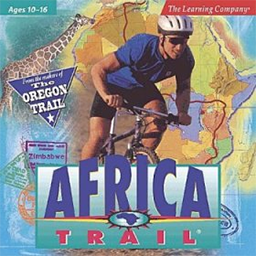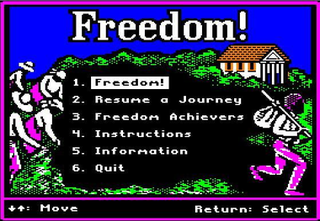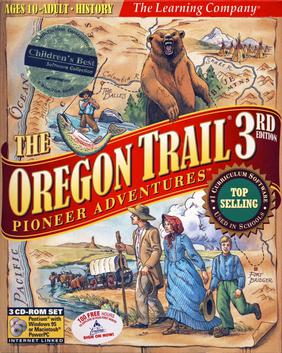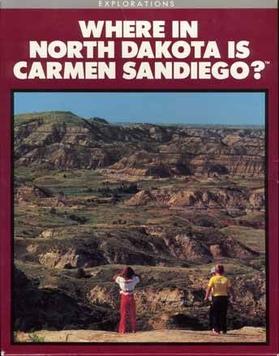
Broderbund Software, Inc. was an American maker of video games, educational software, and productivity tools. Broderbund is best known for the 8-bit video game hits Choplifter, Lode Runner, Karateka, and Prince of Persia, as well as The Print Shop—originally for printing signs and banners on dot matrix printers—and the Myst and Carmen Sandiego games. The company was founded in Eugene, Oregon, and moved to San Rafael, California, then later to Novato, California. Brøderbund was purchased by SoftKey in 1998.

The Oregon Trail is a text-based strategy video game developed by Don Rawitsch, Bill Heinemann, and Paul Dillenberger in 1971 and produced by the Minnesota Educational Computing Consortium (MECC) beginning in 1975. It was developed as a computer game to teach school children about the realities of 19th-century pioneer life on the Oregon Trail. In the game, the player assumes the role of a wagon leader guiding a party of settlers from Independence, Missouri, to Oregon City, Oregon via a covered wagon in 1847. Along the way the player must purchase supplies, hunt for food, and make choices on how to proceed along the trail while encountering random events such as storms and wagon breakdowns. The original versions of the game contain no graphics, as they were developed for computers that used teleprinters instead of computer monitors. A later Apple II port added a graphical shooting minigame.
The Minnesota Educational Computing Consortium, most commonly known as MECC, was an organization founded in 1971 best known for developing the edutainment video game series The Oregon Trail and its spinoffs. The goal of the organization was to coordinate and provide computer services to schools in the state of Minnesota; however, its software eventually became popular in schools around the world. MECC had its headquarters in the Brookdale Corporate Center in Brooklyn Center, Minnesota. It was acquired by SoftKey in 1995 and was shut down in 1999.

Number Munchers is a 1986 video game and a spin-off to the title Word Munchers. It was made by MECC for Apple II, then ported to DOS and Macintosh in 1990. The concept of the game was designed by R. Philip Bouchard, who also designed The Oregon Trail. Two versions of the game were released the Consumer Version and the School Version. After The Learning Company acquired MECC, the game was rebranded as "Math Munchers".

The Amazon Trail is an educational computer game created by MECC. It was inspired by the popularity of The Oregon Trail, featuring the areas surrounding the Amazon River and some of its tributaries. In this 2D adventure, the player is asked to set out on a journey up the Amazon, hoping to make it to the lost Inca village of Vilcabamba. Along the way, the player learns about the people who live on and use the river for their survival. The Amazon Trail is known for being significantly more difficult than its predecessors in the franchise, such as The Oregon Trail. It was released in 1993 for MS-DOS, 1994 for Windows 3.x and 1996 for Windows and Macintosh. Amazon Trail II was released as a sequel to this game and Amazon Trail 3rd Edition was a re-release of that sequel with performance enhancements and new additions.

The Yukon Trail is a 1994 educational computer game from the Minnesota Educational Computing Consortium (MECC), similar to their previous Oregon Trail series but set during the Klondike Gold Rush of the late 19th century. Players start out in Seattle and must make decisions concerning supplies, a partner, and travel plans as they head to Alaska before boating down a river to Dawson City and staking a claim to mine for gold. The game features the famous author Jack London and authentic 19th-century photographs that show what life was like back then.

Africa Trail is an educational computer game developed by MECC and published by The Learning Company. The gameplay resembles that of MECC's other "Trail" games, in which players must prepare for a long journey, choose their traveling companions, and make it safely to their destination. In Africa Trail, players must travel across Africa via bicycle. The game includes a Multimedia Resource Tool to allow players to make their own journal and presentation of the journey.
SoftKey International was a software company founded by Kevin O'Leary in 1986 in Toronto, Ontario. It was known as The Learning Company from 1995 to 1999 after acquiring The Learning Company and taking its name.

Carmen Sandiego is a media franchise based on a series of computer video games created by the American software company Broderbund. While the original 1985 Where in the World Is Carmen Sandiego? video game was classified as a "mystery exploration" series by creators and the media, the series would later be deemed edutainment when the games became unexpectedly popular in classrooms. The franchise centers around the fictional thieving villain of the same name, who is the ringleader of the criminal organization V.I.L.E.; the protagonists are agents of the ACME Detective Agency who try to thwart the crooks' plans to steal treasures from around the world, while the later ultimate goal is to capture Carmen Sandiego herself.

Freedom! is a 1993 educational computer game developed and published by the Minnesota Educational Computing Consortium (MECC). Based on similar gameplay from MECC's earlier The Oregon Trail, the player assumes the role of a runaway slave in the antebellum period of American history who is trying to reach the North through the Underground Railroad. The game was developed with help of an African-American consultant who guided MECC on appropriate graphics and dialect that represented the era. It is recognized as one of the first video games dealing with the topic of slavery.
Encore Software, LLC ("Encore") is a Delaware limited liability company focused on software sales, distribution and software development.

The Oregon Trail 3rd Edition is the second sequel to the 1985 edutainment video game The Oregon Trail after Oregon Trail II. It was developed by MECC and released in 1997.

The Oregon Trail 4th Edition is a 1999 video game, and the third sequel to The Oregon Trail. Players learn teamwork, supply management, critical-thinking, and decision-making.

Where in North Dakota Is Carmen Sandiego? is a 1989 edutainment video game. It is the fourth game in the Carmen Sandiego video game series after World (1985), U.S.A. (1986), and Europe (1988). Having observed the popularity of the Carmen Sandiego franchise in the education of school children, educators were inspired to develop a North Dakota version to teach North Dakotans about their state's history and geography.

The Oregon Trail 5th Edition: Adventures Along the Oregon Trail is a 2001 video game, and the sequel to The Oregon Trail 4th Edition.

Amazon Trail II is a simulation video game developed by The Adventure Company and published by MECC for the Macintosh and Windows. It was released in September 1996. The game is a spin-off of The Oregon Trail.
The Oregon Trail is a series of educational computer games. The first game was originally developed by Don Rawitsch, Bill Heinemann, and Paul Dillenberger in 1971 and produced by the Minnesota Educational Computing Consortium (MECC) in 1974. The original game was designed to teach 8th grade schoolchildren about the realities of 19th-century pioneer life on the Oregon Trail. The player assumes the role of a wagon leader guiding a party of settlers from Independence, Missouri, to Oregon's Willamette Valley via a covered wagon in 1848.
Hexagony is an abstract strategy board game for 2 to 6 players that was published as Bin'Fa by Taoist Arts Inc. in 1977, as Hexagony by Avalon Hill in 1980, and later re-released in a slightly modified form by Kenterprises as Bin'Fa.

The Oregon Trail is an educational strategy video game developed and published by the Minnesota Educational Computing Consortium (MECC). It was first released in 1985 for the Apple II, with later ports to DOS in 1990, Mac OS in 1991, and Microsoft Windows in 1993. It was created as a re-imagining of the popular text-based game of the same name, originally created in 1971 and published by MECC in 1975. In the game, the player assumes the role of a wagon leader guiding a party of settlers from Independence, Missouri, to Oregon's Willamette Valley via a covered wagon on the Oregon Trail in 1848. Along the trail, the player makes choices about supplies, resource management, and the route, and deals with hunting for food, crossing rivers, and random events such as storms and disease.















